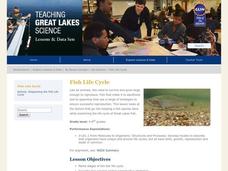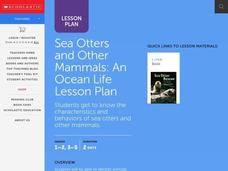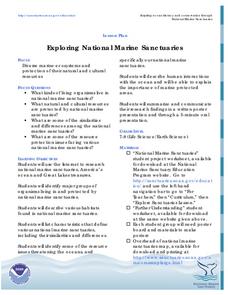Alabama Wildlife Federation
Butterflies without Borders
Some living things go to extreme measures to avoid the cold. A three-part activity guides learners through the migration of the monarch butterfly. After studying the life cycle of the monarch butterfly, pupils learn the process of...
Aquarium of the Pacific
Kelp Forest Habitat
What forest is in the ocean? The class watches a video that introduces the kelp forest and the parts of kelp. Learners dive into the ocean and see what different species live near the canopy, the midwater, and the bottom of the kelp...
National Wildlife Federation
Plastic in the Sea
How much plastic do people use? Class members identify how plastic is involved in their daily lives by looking at food packaging either at a grocery store or at home. Learners view statistics for the amount of plastics found on a beach...
CK-12 Foundation
Marie Curie's Classroom
What makes some elements stable and others radioactive? Scholars adjust the number of protons and neutrons in an element then observe its decay. The simulation includes a graphical representation and the chemical formula, as well as...
Curated OER
The Science of Aging
Students reflect on the lives of older people they know, then research and debate the key issues surrounding scientific experimentation in anti-aging. They write a short story that reflects their own philosophical beliefs on aging and...
Curated OER
The Language of Science
In this language of science worksheet, students use the list provided to guess the meaning of each of the list. Students apply root words, prefixes, and suffixes to gain meaning of other science words.
Curated OER
Life Cycles
In this life cycles worksheet, students compare the life cycles of 2 different species and answer short answer questions about them. Students can choose the species to compare and then answer 6 questions.
Curated OER
Living vs. Nonliving
Learners explore the characteristics that distinguish living things from nonliving things. Students examine video clips and still photographs to gather evidence and develop criteria to decide if something is living or nonliving.
Michigan Sea Grant
Fish Life Cycle
Fish are no different when it comes to a living being's primary objective—to reproduce. They do differ, including from fish species to fish species, in their life cycles, survival tactics and reproductive strategies. After discussion of...
Curated OER
Classifying Living Things
Young scholars identify how to classify living things. They classify various concepts including family members, kinds of clothing, numbers, shapes, and vocabulary words. They discuss how to classify various concepts and classify...
Curated OER
Ocean Life
Students identify marine mammals according to specific characteristics. Students read about marine mammals and list their characteristics. Next, students play a Whale and Otter game on the playground to simulate whales swimming across...
Curated OER
Marine Animal and Plant Adaptations
Students examine nature by creating their own animals. In this animal adaptation lesson, students define scientific vocabulary terms dealing with adaptation such as sea stars, sea cucumbers and exoskeleton. Students utilize their...
Curated OER
Living or Nonliving
Students explore the characteristics that distinguish living things from nonliving things. By examining video and photographs, students gather evidence and develop criteria to decide if something is living or nonliving.
Curated OER
Science and Careers
Students investigate how knowledge of science influences people in their daily lives, specifically in their careers. Students conduct interviews with an individual in a science or technology career as part of their research on the impact...
Curated OER
Decomposition, Soil, and Life Cycle Research
Students conduct background research on the decomposition process, soil composition, and the life cycle using the resources provided for Internet searches. They work in collaborative groups to research topics as a particular plant, soil...
Curated OER
Life Cycles
Third graders investigate the stages of animal life cycles. They examine an egg and compare it to an inanimate object, read a booklet about the life cycle and define key vocabulary terms, and observe a mealworm. Students then design a...
Curated OER
Searching for life
Young scholars explore the possibility of life on Mars and what that might look like. In this planetary lesson students complete several activities on looking for life on Mars.
Curated OER
Math in Science-Radioactive Decay and Half-Life
In this radioactive decay and half-life instructional activity, students use given half-lifes to calculate the amount of time it will take for certain amounts of elements to decay. They also find the age of samples and determine how many...
Curated OER
My Life As An Insect In Namib
Students examine the harsh living environment of the Namib Desert. They watch and discuss a video, record the types of insects observed in the video, record information about insects and animal adaptations in their science journals, and...
Curated OER
What Is Life?
For this life characteristics worksheet, students answer 16 questions about living things, Redi's experiment, basic needs, growth and development.
Curated OER
Exploring National Marine Sanctuaries
Young scholars research marine ecosystems by creating class presentations. For this oceanography lesson, students research the different locations of marine sanctuaries by identifying them on a transparency map in class....
Curated OER
The Game of Life
Students describe what it means for a marine animal or fish to be threatened or endangered after playing game simulating extinction.
Curated OER
Brine Shrimp Life Cycle
Third graders examine brine shrimp through "A Sea Monkey's Life" story. They study the living environments and life cycle of brine shrimp. They look at brine shrimp and cysts through a microscope, identifying new vocabulary that was...
Curated OER
The Circle of Life
Fourth graders examine how the different organisms living in an ecosystem affect one another. In groups, they research a specific ecosystem and present their findings to the class based on the type of organisms found in it. To end the...























